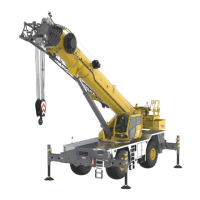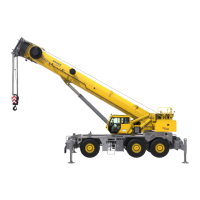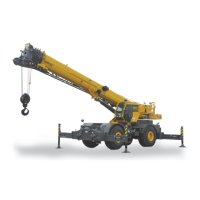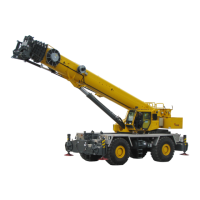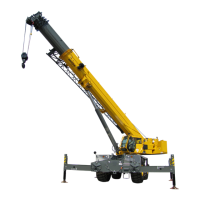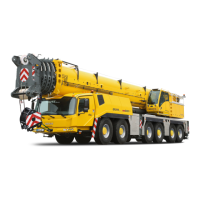HYDRAULIC SYSTEM GRT8100 SERVICE MANUAL
2-16
Published 3/26/2018, Control # 596-05
OIL COOLER
Description
An air cooled hydraulic and transmission oil cooler
(Figure 2-3) is located on the left side of the crane. The
hydraulic oil cooler section is located closest to the front of
the crane and the transmission oil cooler is located closest to
the rear of the crane.
The return oil circuit for all functions on the carrier
combination manifold bypasses the hydraulic cooler and
returns directly to the hydraulic oil filter in the hydraulic tank.
The return oil circuit for all other functions is directed through
the hydraulic oil cooler and on to the hydraulic oil filter. A
15 psi check valve in this return oil circuit diverts oil to the
return circuit which bypasses the hydraulic oil cooler if the
return oil pressure ever increases due to several functions
being operated simultaneously.
A hydraulically driven fan pulls cool air through the cooling
fins on the two coolers. The fan is turned on and off as
needed by a temperature switch (120°F rising) that is
installed in the hydraulic oil tank. A thermistor (200°F rising)
is installed in the hydraulic oil tank which will cause a warning
light in the cab to illuminate if the hydraulic oil temperature is
too high. The thermistor will also turn on the oil cooling fan if
the temperature switch fails.
Maintenance
The oil cooler should be checked daily for dirt buildup, as a
dirty cooler will result in high oil temperatures. High oil
temperatures will reduce the performance and useful life of
the oil, which can ultimately result in component failure.
If the cooler is contaminated with dust, it can be cleaned
using compressed air. If the cooler is contaminated with a
mixture of oil and dust, it should be disassembled and
treated with a liquid cleaner, then cleaned of debris using
compressed air. Take care when using compressed air, a
high pressure washer, or a steam cleaner, as the fins of the
cooler may be damaged. To ensure effective cleaning, the
direction of air, water, or steam must be opposite to the
direction of normal airflow through the cooler. On cranes that
operate in corrosive environments (salt), frequently clean the
cooler with water to help prevent corrosion.
